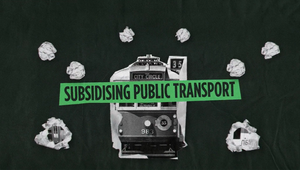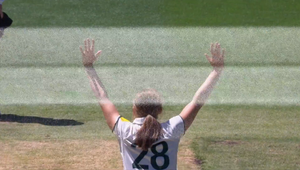
How Mastercard and Howatson+Company Created a Motion Picture without The Moving Pictures

Going to the cinema is a wonderful experience. The room is dark, the smell of popcorn is embedded in the walls of the cinema. An epic tale unfolding right before your eyes.
But if one was to take away the images and replace them with a blank screen, what sort of experience would that be like? How would that change the way we go to see movies? Can this open up the cinema experience for the visually impaired?
These were the questions that Mastercard and Howatson+Company decided to answer. Together they produced ‘TOUCH’, a motion picture without the moving pictures. A collaboration done in order to showcase how easy it can be to create accessible experiences for those who need and want them.
It is estimated that 575,000 people living within Australia are blind or have low vision. That’s 575,000 people who have a completely different experience to the average movie goer.
LBB’s Casey Martin spoke with Howatson+Company’s executive creative director, Gavin Chimes about the new possibilities that have been opened up due to this campaign.
LBB> How did the project come about? What was Mastercard’s brief to you?
Gavin> Breaking down barriers and making the world more inclusive is part of Mastercard’s brand ambition. Their new Touch Card features unique tactile notches to make identifying the different cards in their wallet easier for the blind and low vision community.
With two of Australia’s largest banks now issuing the Touch Card to millions of cardholders, Mastercard wanted people to understand that these cards were not just a new design idea but were created to make a material difference to people’s lives. The task was to educate consumers at mass scale about this new feature, while creating a conversation about designing the world for everyone. So, we decided to bring the thinking behind Touch Card to life in a new way and redesign another experience that had traditionally catered to the sighted community.
The idea for cinema came from looking at what assets we could use from Mastercard’s issuing partner, Westpac. As the major sponsor of Sydney’s iconic Open Air Cinema, we saw an opportunity to change the way people who are blind and low vision experience the movies. The campaign snowballed from there.
LBB> Talk us through the idea.
Gavin> Mastercard’s ‘TOUCH’ is a feature-length motion picture without pictures. Brought to life solely through Dolby 7.1 sound, without images or audio descriptions. Made so all audiences can enjoy the magic of cinema together, no matter their level of vision.
It follows an original story of a neuroscientist trapped inside his father’s mind, along with his ex-girlfriend and an unsuspecting delivery driver. To escape, they must journey through crumbling memories and forgotten worlds.
This film was developed in collaboration with consultants, sound designers, composers, writers and actors from BLV communities across the world – alongside award-winning filmmakers.
LBB> Why was this particular project so important to you? Did you learn something about the work or about yourself that you didn’t expect to?
Gavin> The cinema has always been my happy place. Before I had kids, I went every weekend. Seated middle-back, boysenberry choctop in hand, I’d lose myself in whatever was on screen. New releases, foreign film festivals, reruns of classics in uncomfortable arthouse theatres. For me, movies represent the ultimate expression of creativity, where different crafts come together to tell a story: writing, sound, directing, cinematography, acting. And watching them in the cinema is a transportive, meditative experience. Something to savour with all the senses.
Yet, until working on Mastercard ‘TOUCH’, I never considered what the cinema was like for people who don’t have all their senses. For those who are blind or have low vision, watching a movie in a theatre is a very different experience. They rely on screen readers or clunky audio descriptions to explain what’s happening on screen. It’s not just a compromised experience, it’s one that separates them from the rest of the audience.
With Mastercard ‘TOUCH’, we strived to create a more inclusive cinema experience. One that could be enjoyed by everyone on an equal level.
Giving others a chance to feel included in an experience that has brought me so much joy has been incredibly important. And being able to develop an entire feature length film from scratch has been a tremendous privilege from a creative perspective. Together with blind and low-vision creators, and our brilliant director Tony Krawitz, we wrote an original screenplay, innovated new ways of using sound in film with Oscar-nominated Wayne Pashley and recorded dialogue with some of our country’s best actors. It was a taste of Hollywood-level filmmaking that we rarely get to experience in the advertising industry.
LBB> What were the unexpected challenges and how did you overcome them?
Gavin> There were many challenges making this project but each one helped shape it for the better. Originally, we set out to find a pre-existing screenplay and adapt it to be audio-only. After reading countless scripts, we realised we needed to build the story from the ground up so we could authentically engage the blind and low vision community, work with them to shape the film, add their insights, feedback and more. So, with just two months until the premiere, we assembled a team of writers composed of creatives from Howatson+Company (Jared Wicker and Scott Zuliani), Hollywood screenwriters (Emile and Sigmund Stern), our director and his blind attachment Benjamin Philips. Together, we wrote an entire feature-length screenplay from scratch. It was an experience as exciting as it was terrifying.
Another major challenge was in developing the score. We wanted to engage not only the best composers from around the world, but those that could bring their own unique perspective and lived experience to the project. This meant we had to be flexible to adapting the film based on the global talent we found. For instance, our head composer (Berlin-based Jonathan Dreyfus) discovered a blind eight-piece band in Mongolia, so we rewrote scenes to give them a place in the film and flew Jonathan to Ulaanbaatar to record with them.
LBB> What was the proudest moment of working on this moving picture without the moving pictures?
Gavin> Two moments stand out for me. The first was when we finished recording with the actors, when Benjamin Phillips, our blind director’s attachment, gave an impromptu speech. Crying, he said listening to the recording made him feel, for the first time, that he didn’t have a disability. There wasn’t a dry eye in the room.
Another proud moment was when we premiered ‘TOUCH’ at Sydney’s Westpac OpenAir. 800+ seats filled with film fans, media and people from the blind and low vision community, sitting alongside sighted friends and family. No one there had ever experienced a film like that.
LBB> How do you feel knowing that they have not only allowed for more accessible experiences but will also impact the education of future creatives coming into the industry?
Gavin> ‘TOUCH’ has already been turned into a lesson module and shared with dozens of global top-tier film schools, giving future filmmakers a blueprint to make more inclusive productions. Requests for in-person or online masterclasses with Q&A from the film's director, the director's blind attachment, and representatives from Bus Stop Films are available. By inspiring the next generation of filmmakers to take an inclusive approach to creating content, we can begin to reshape the entire entertainment industry - from how films are watched and how they can be made. You can see the lesson plan here.
LBB> What did you learn and how will it continue to impact the work you make?
Gavin> I learnt that true inclusivity isn’t just about casting someone with a diverse background in a project, it’s about engaging them from the beginning of a production. And incorporating their guidance and feedback. This isn’t a compromise to the work, it’s how it becomes better.
I also learnt that unflappable belief is a creative’s superpower. It inspires clients. It motivates directors. It galvanises everyone who touches a job. It turns crises into solvable problems. And it lets you create an entire feature length film in just a couple of months.
Finally, something I knew that was reinforced was that you’re only as good as the team around you. This project was made possible because of the incredibly talented people who I work with every day at Howatson+Company. They care fiercely every day and it’s a privilege working with them.
LBB> When relying solely on sound alone to tell a story, how did you go about the creation process?
Gavin> We began by engaging director Tony Krawitz and Bus Stop Films as an inclusivity partner. They helped us identify 34 members of the blind and low vision community with a shared passion for this project to help bring it to life. With representation across every department, for many of the team this was their first break in the industry, while helping the team at large consider their perspective at every stage.
With their help, we wrote an audio-first screenplay; an original story of a neuroscientist trapped inside his father’s brain after an experiment gone wrong, alongside his ex-girlfriend and an unsuspecting delivery driver. To escape, they must journey through forgotten worlds and crumbling memories.
To ensure that audio was driving the story, every key sound was written into the script, which was refined by three separate focus groups with the blind and low vision community. Afterwards, every scene was mapped through storyboards to give audio engineers a sense of sonic location and space.
When it came to crafting the scenes, we brought together our sound engineers to innovate new ways of using sound in cinema. For instance, we developed sonic versions of visual techniques, like crash zooms, to give the edit energy. Characters’ footsteps had clear ‘weight’ to provide a sense of size. Their voices had different subharmonics to provide a sense of distance. We even walked through mincemeat to create just the right foley.
The result is an immersive cinema experience unlike any radio play or audio project before, with over 900 audio tracks. One that uses Dolby Atmos to make use of every speaker in the theatre – including surround sound, upper rear and ceiling.
The movie also featured an original score of 17 tracks, inspired by Mastercard’s sonic brand identity and written and performed by some of the best blind and low-vision composers and session musicians from around the world – leading to recording sessions in Berlin, Sydney and Mongolia.















